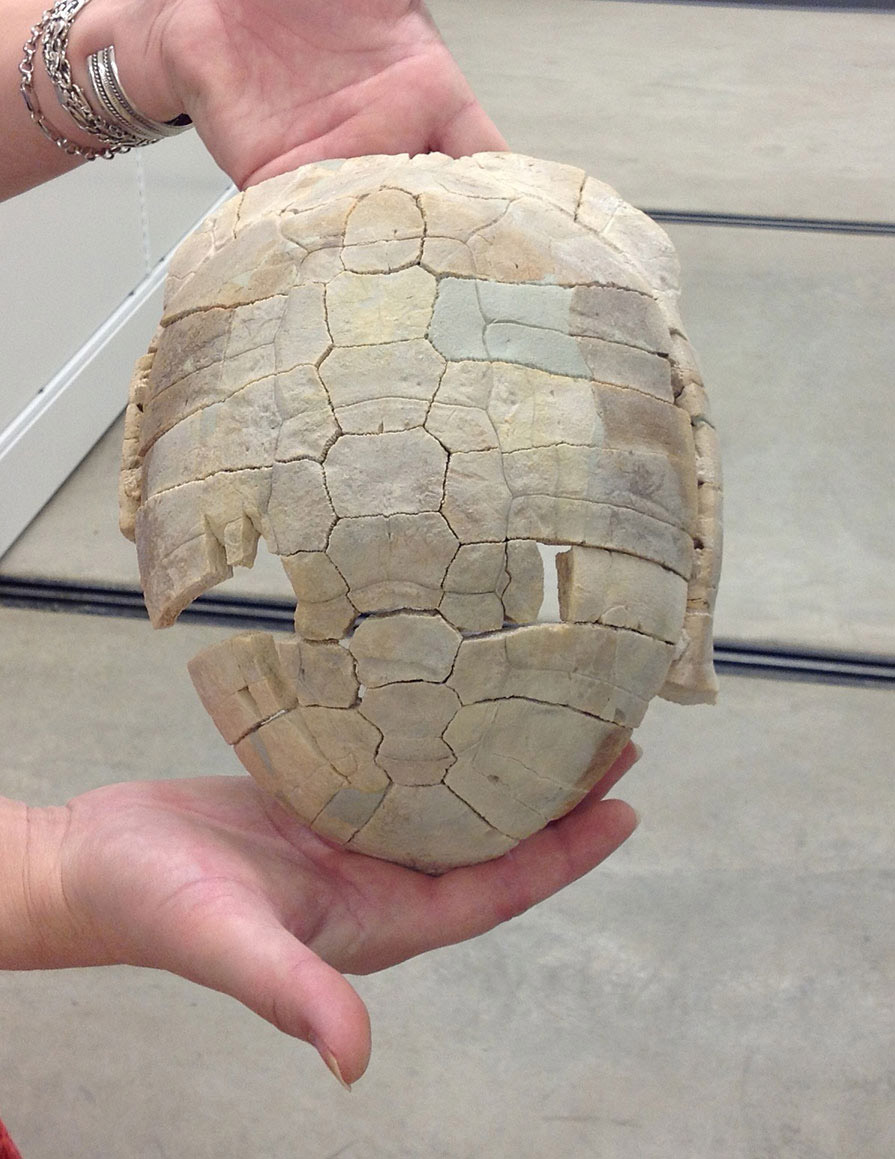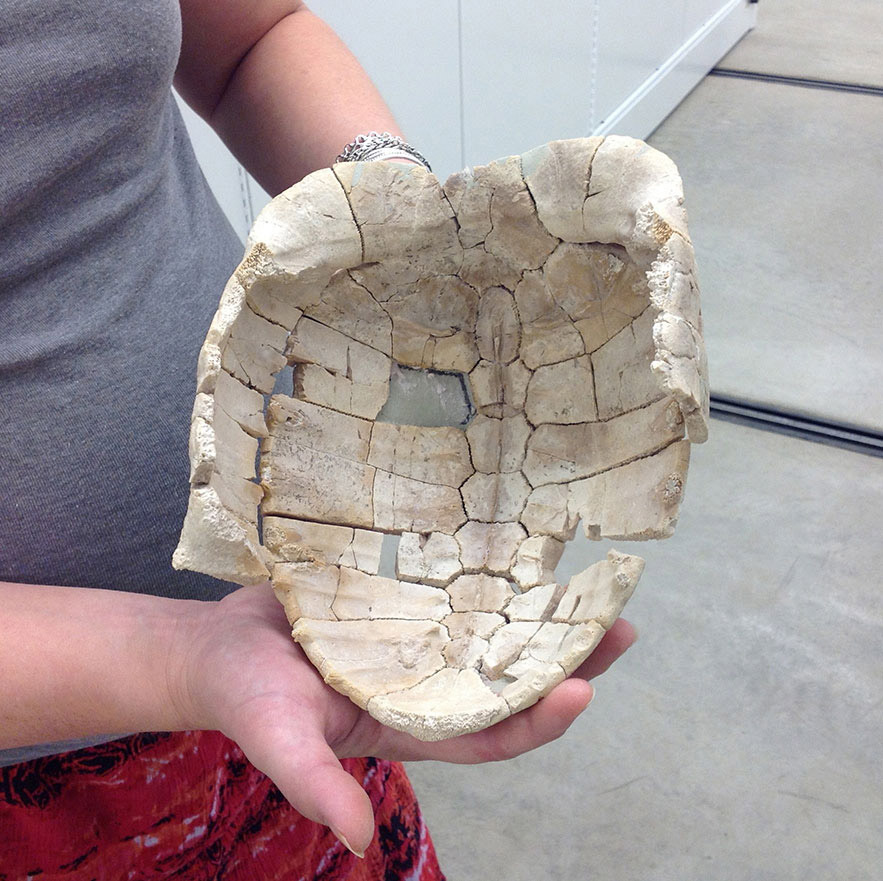Introduction
The earth changes constantly. During the average human lifespan, we may see only a few major geological changes. The erosion of a creek bank or the rising water elevation of a lake can take place in a matter of a few years. Other changes such as the rising of a mountain range can take centuries and we are not likely to see those changes during visits to that place. The geological formations, the climate, the plants, and the soil all undergo changes over time. Those changes affect animals (fauna), too. If they can adapt or migrate to a more favorable location, they might survive. If those strategies fail, the animals might become extinct, meaning they will no longer exist.
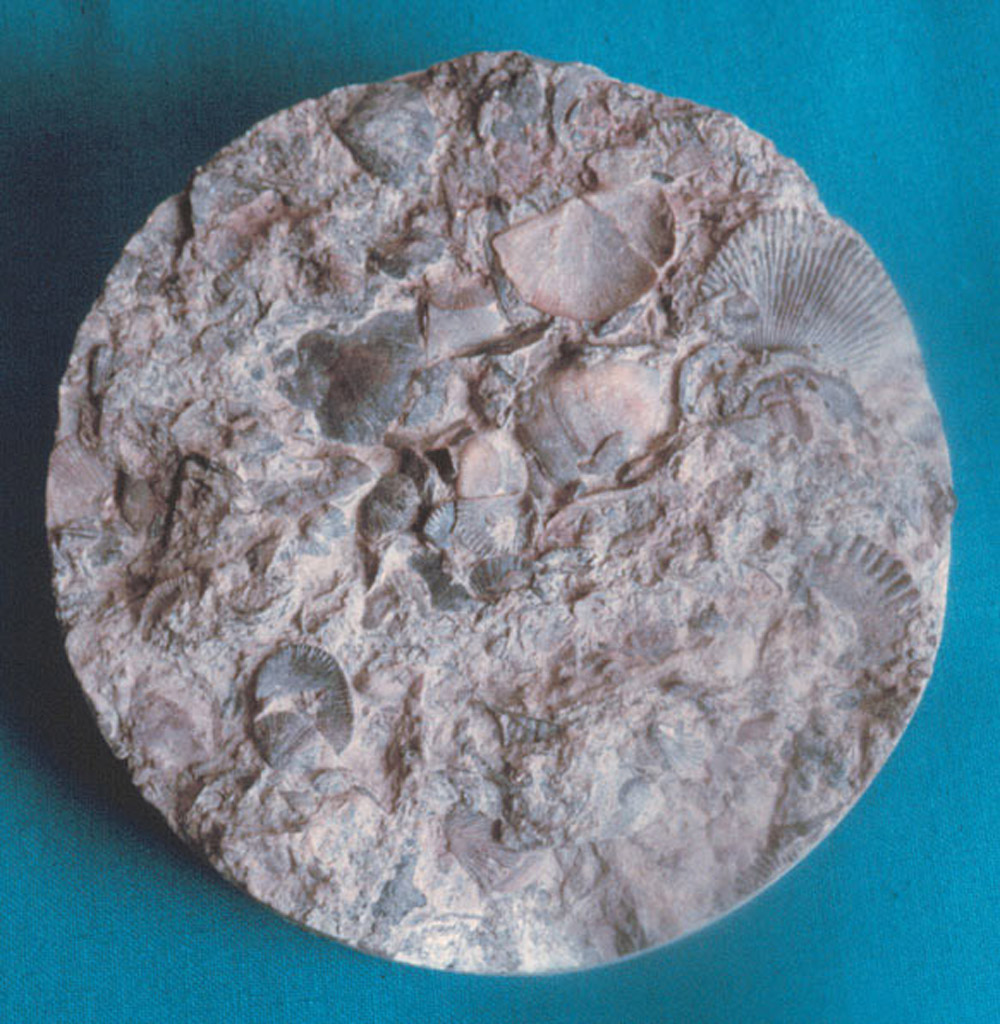
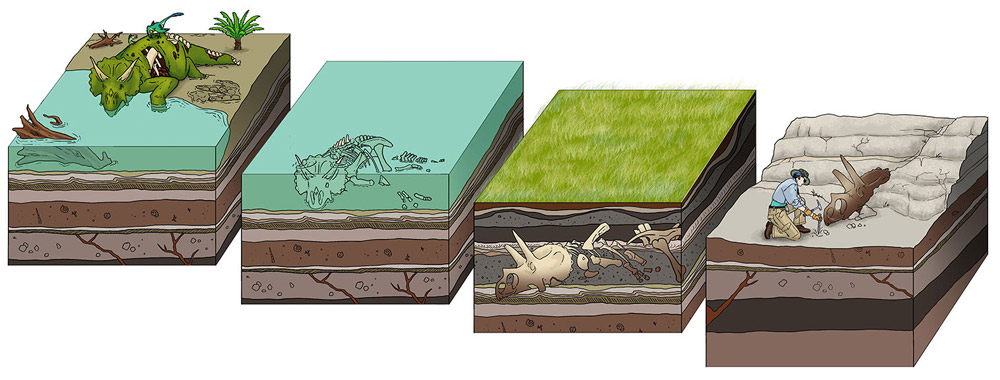
Over the 500 million years of North Dakota’s ancient pre-history, thousands of species of animals have swum, walked, run, burrowed, slithered, and flown in this landscape. Some of those animals have become extinct; others are still with us in some living form. We learn about the ancient animals through the fossilized remains found in the geological formations of North Dakota. (See Image 11.)
The kinds of animals (species) that lived here changed with the climate and other factors including food supply and predation (hunted by other animals.) More than 500 million years ago,How do we know who lived here 500 million years ago? Are there fossils to examine? How do we find those fossils, you ask, knowing that there are no exposed rocks in North Dakota from that ancient (Cambrian Period) time? The answer is OIL! When petroleum geologists drill into the earth looking for oil, the drills return “cores” (cylinders full of rock) to the surface. Some of these cores come from as much as 14,000 feet below the surface (the Deadwood Formation.) Many of these cores contain fossils. Because the drills cut straight down through all the layers below the surface, each layer can be identified, so we know how old the fossils in the cores are. the typical animals of the region were microscopic animals including conodonts (KON oh donts; worm-shaped, possibly vertebrates), brachiopods (BRACK ee oh pods; clam-like), trilobites (TRI lo bites; three-part), and snails. (See Image 12) Much of the state was periodically covered by warm, shallow seas until about 65 million years ago.
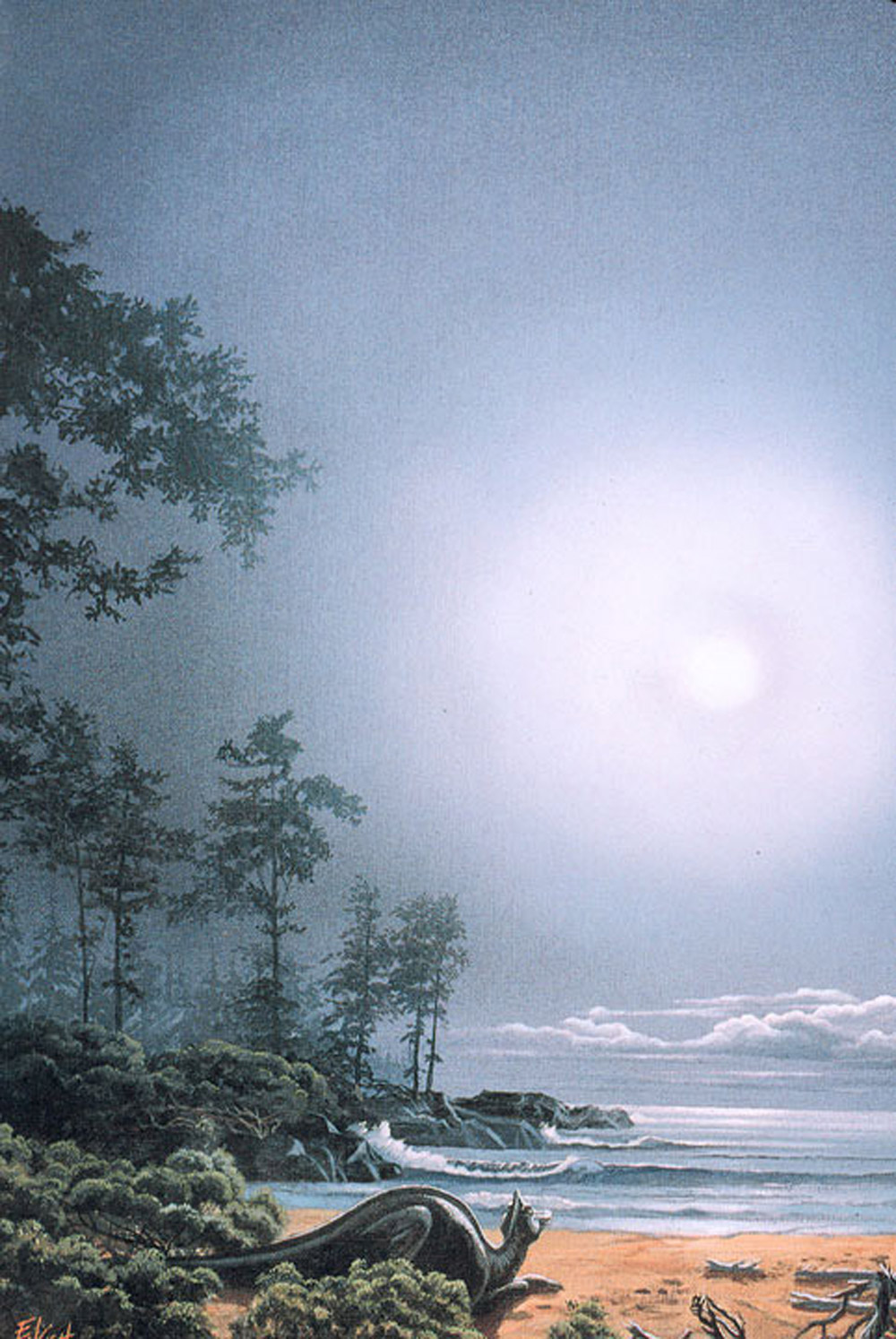
In time, animals with vertebrae (backbones) developed. Some vertebrates lived on land, some in the water, and some flew through the air. Vertebrates included dinosaurs, lizards, and mammals. The fossil records of these animals are visible in the exposed strata (layers) of North Dakota.
At the end of the Cretaceous Period, about 65 million years ago, a cataclysmic event caused the extinction of the last of the dinosaurs and nearly three-fourths of all the species of plants and animals on earth. The event is called the K-T boundary. It marked the end of the Cretaceous Period and the beginning of the Tertiary Period. No longer did reptiles dominate the animal kingdom as they did during the Mesozoic Era. After the K-T boundary, mammals became the dominant animals of earth (Cenozoic Era).
Scientists debate the cause of this extinction event. Many scientists believe that extinction came about after a giant asteroid, more than six miles in diameter, struck Earth along the eastern coast of Mexico. (See Image 13.) The explosion was a billion times greater than the force of the first atomic bomb which was dropped on Hiroshima in 1945.
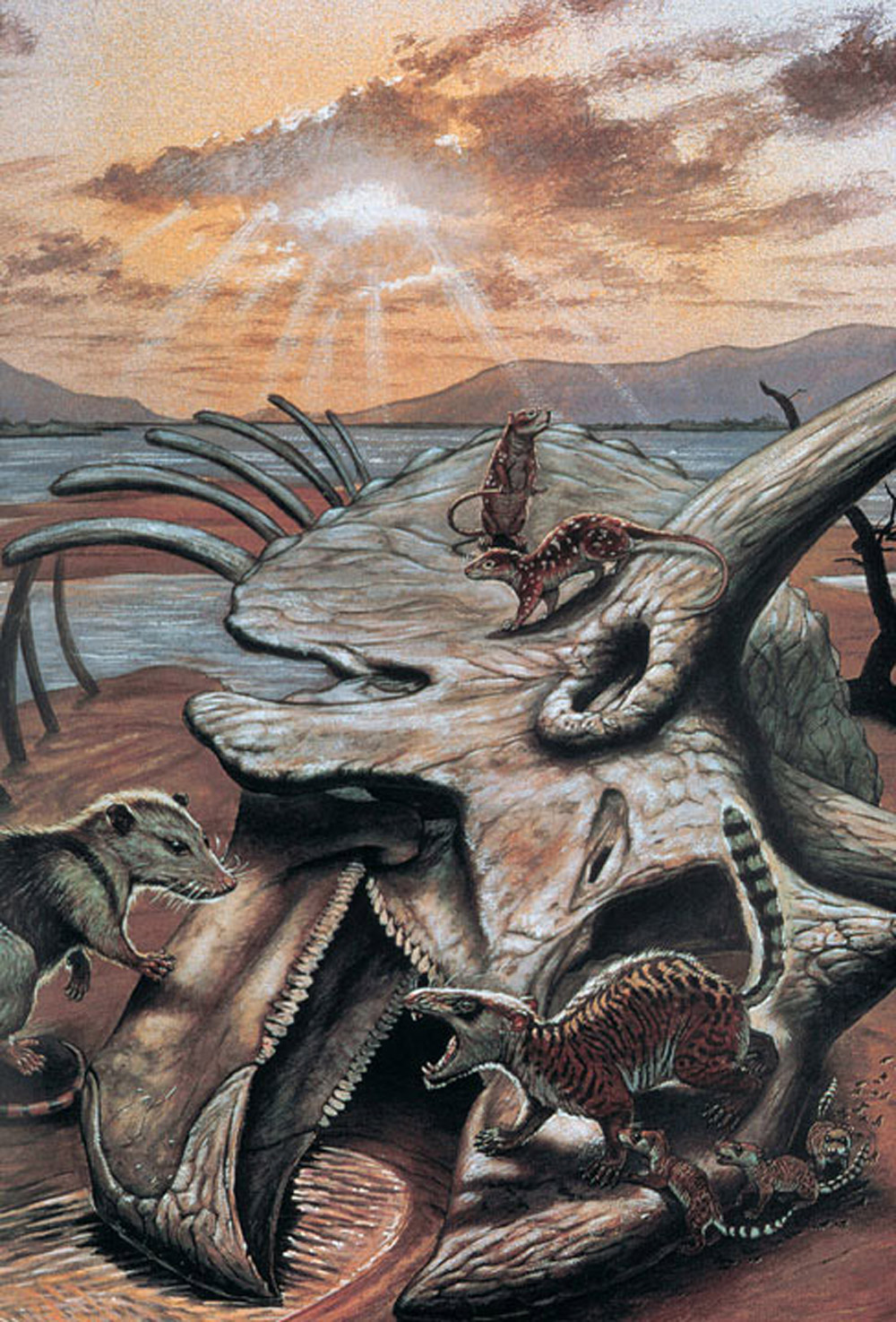
The asteroid’s impact zone was perhaps several hundred miles wide. Plants and animals nearby would have been vaporized. The heat released by the impact probably killed animals all over the world. In addition, the dust cloud that rose at the collision site, caused Earth’s climate to become colder because it blocked sunlight. Colder temperatures caused plants to die which led to the deaths of animals that depended on those plants.
This theory is backed by significant geological evidence. There is a crater, 100 miles wide and 10 miles deep beneath the Yucatan Peninsula of Mexico. A thin layer of clay containing iridium (rare on Earth, but found in asteroids) lies between the last layers of the Cretaceous Period and the first layers of the Tertiary Period. This layer may have resulted from the explosion of the asteroid. The geological K-T boundary, identified by the presence of iridium, is exposed in some places in North Dakota.
Though the asteroid theory is important, it is also true that dinosaurs appear to have been diminishing in numbers and biological importance in the Late Cretaceous Period. In addition, though the event killed off many of Earth’s life forms, some animal species did survive.
The K-T boundary was not the only period of extinction. There were other major extinctions and several minor extinctions. However, this particular extinction is important because it led to a long period of time when mammals evolved and expanded. (See Image 14.)
Animals of the Cretaceous Period
Between 85 and 65 million years ago (the Late Cretaceous Period), animals lived in North Dakota on land, sea, and in the air. The Western Interior Seaway put much of North Dakota under a warm shallow sea for millions of years. The seas were filled with many small creatures such as clams, corals, and urchins, and lobsters. But there were also sea creatures we might call monsters because of their size and eating habits. Fossils of these animals have been found in Pierre Formation sites near Cooperstown and in the Pembina Gorge.
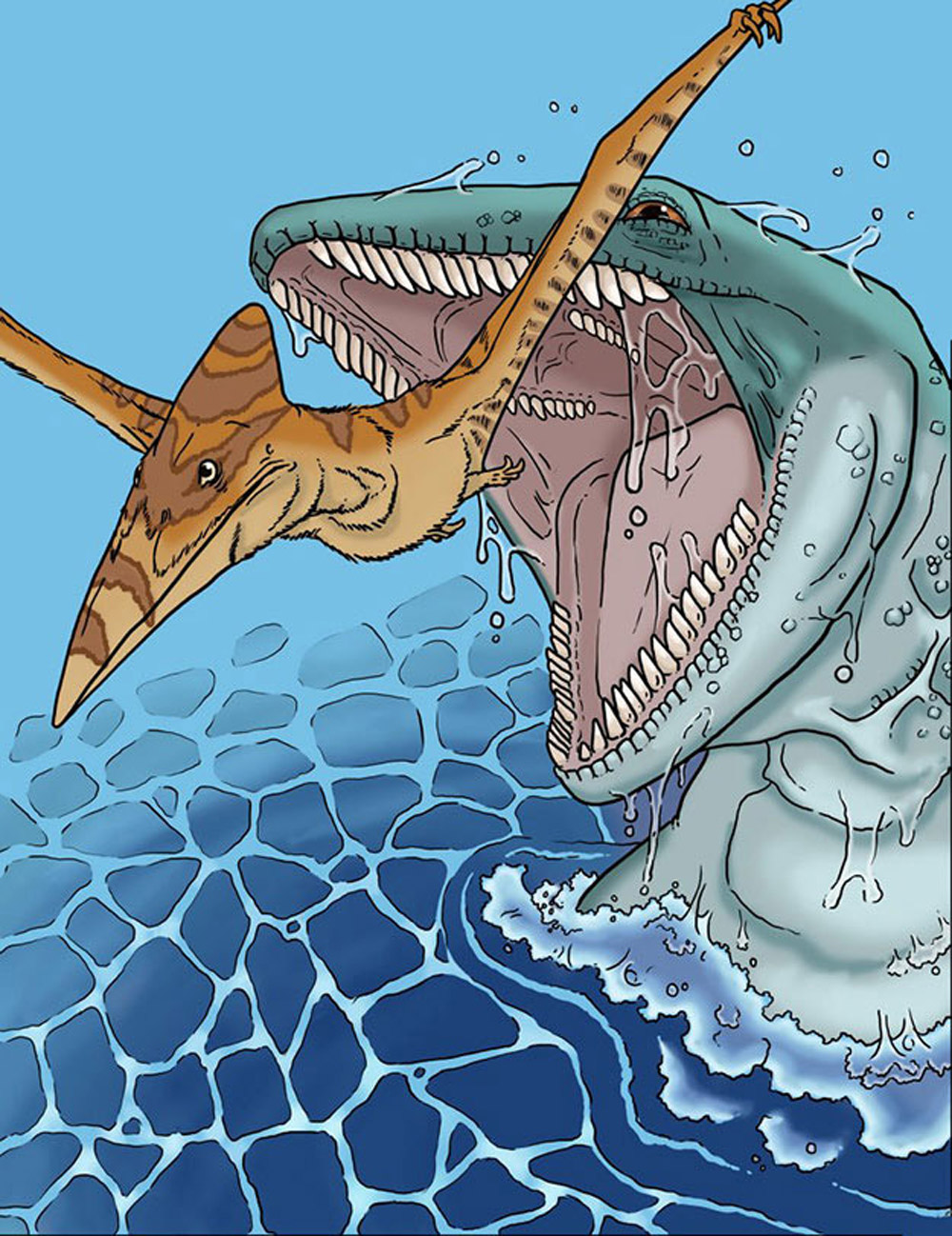
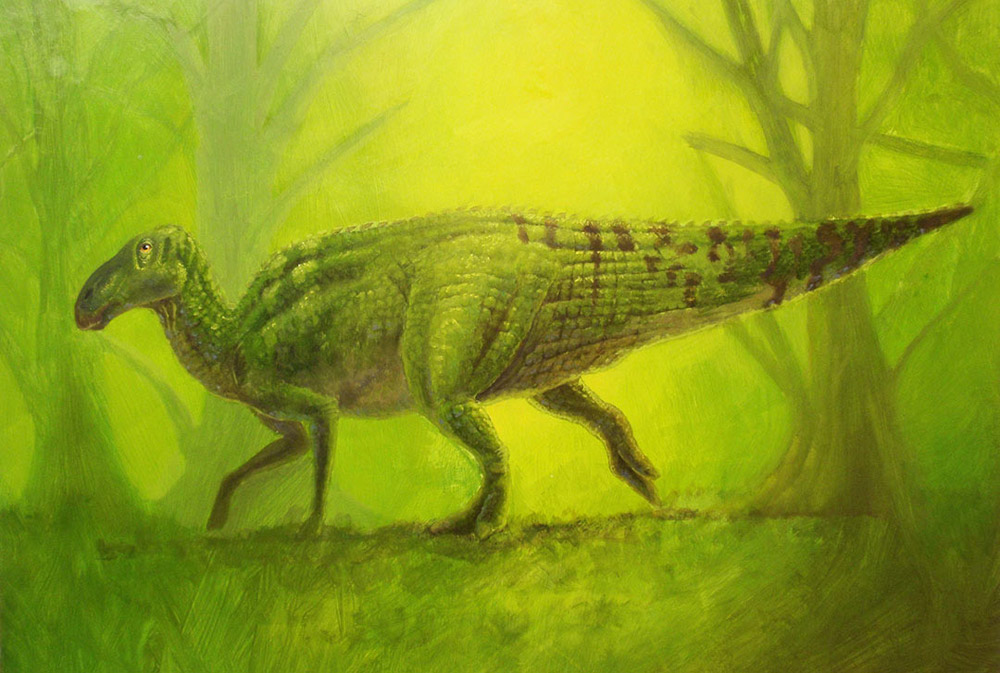
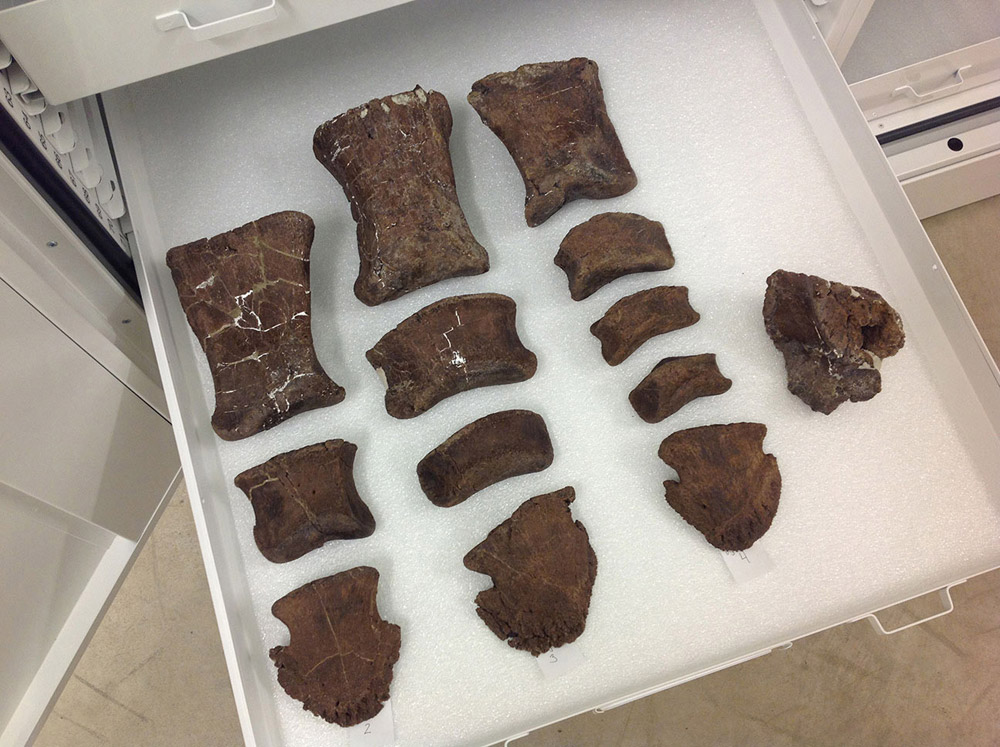
The Plioplatecarpus (PLY oh plat ee CAR pus), or mosasaur (MOZE ah sore), (See Image 15.) was one of the large predators of the inland sea. These were not dinosaurs, but marine lizards (related to the modern Komodo dragon) that could be as much as 40 feet long. They ate fish, other mosasaurs, and a swift, water-diving, flightless bird, the Hesperornis regalis (hess per OR niss ree GAL liss). Mosasaurs battled sharks and giant 35-foot-long squids called Tusoteuthis longa (tooz oh TOO thiss LONG ah). Another monster fish was the Xiphactinus (zy FAK tin us). This fish had an ugly snout with fangs that protruded from its lips. The predatory Xiphactinus was as much as 20 feet long. Life wasn’t peaceful in those waters.
Late in the Cretaceous Period, the sea drained away in western North Dakota and a delta formed where water flowed down from the Rocky Mountains into North Dakota. The delta led to the Fox Hills Sea in south central North Dakota. The sediments deposited in this delta came to be known as the Hell Creek Formation. Forests of now-extinct flowering trees grew on the plains. Palms, fern, and conifers grew along the shores of the Fox Hills Sea.
The land animals of the Cretaceous are well-represented in the Hell Creek Formation. The fossils of 14 different species of dinosaur (which are a type of reptile) have been discovered here.Though dinosaurs lived during the Triassic Period (251 to 201 million years ago), we have not yet found fossilized remains of that age in North Dakota. Paleontologists have found dinosaur fossils only the Hell Creek Formation (75 to 65 million years ago) in North Dakota.
Dinosaurs, by the way, were not lizards, but a different sort of reptile. They laid eggs and, like modern birds, some cared for their young hatchlings and some did not. It is very difficult to determine the sex of an individual dinosaur from the fossilized remains.Most of North Dakota’s dinosaurs were large herbivores (plant-eaters). The Triceratops (tri SAIR ah tops) was a plant-eater though it might appear to be ferocious because of its three large horns and powerful, heavy body. It could be 25 feet long and weigh more than eight tons. The Triceratops was well-equipped to defend itself against many predators.
Another herbivore of great size was the Edmontosaurus (ed mont oh SORE us) (See Image 16.) which was a type of Hadrosaur (HAD dro sore) or duck-billed dinosaur. Parts of many Edmontosaurs have been found in North Dakota. (See Image 17.) A few years ago, a special Edmontosaur was found in the Hell Creek Formation near Marmarth. This dinosaur, named Dakota, has fossilized skin. (See Image 18.) The skin is so well preserved that it is possible to see scales of different sizes on various parts of the body. Dakota’s tail is so perfectly preserved that paleontologists have learned that the tail of the Edmontosaur is larger than previously thought. Scientists have also learned more about the structure of the muscles in the hips from studying the tail.Dakota the Edmontosaurus was found by a 16-year-old Marmarth boy named Tyler Lyson. Tyler had been hunting for fossils in the Hell Creek Formation since he was a young boy. He had already located a site populated with ancient turtle fossils that he called the Turtle Graveyard (now known to be the world’s most important fossil turtle site), and he had found many fossilized remains of ancient creatures. He had enough experience to know that when he found part of the skin of an Edmontosaurus poking out of the rocky ground, he had found something very important. He called Dr. John Hoganson at the North Dakota Geological Survey. With the help of many others, they carefully excavated the fossilized dinosaur and took it to the Heritage Center paleontology lab in Bismarck to clean and examine the fossil. It became clear that Dakota, as the fossil was named, could teach us much about dinosaurs.
Tyler Lyson attended Swarthmore College where he studied paleontology. He went on to Yale to earn a doctoral degree in paleontology. His college studies focused on the evolution of turtles. He found that turtles, which are reptiles, are most closely related to lizards.
Today, Dr. Lyson works for the Denver Museum of Nature and Science where he continues his paleontological studies. He has also established the Marmarth Research Foundation to foster the study of Hell Creek fossils. You can read the Marmarth Research Foundation newsletter at mrfdigs.com/excavations/turtlegraveyard
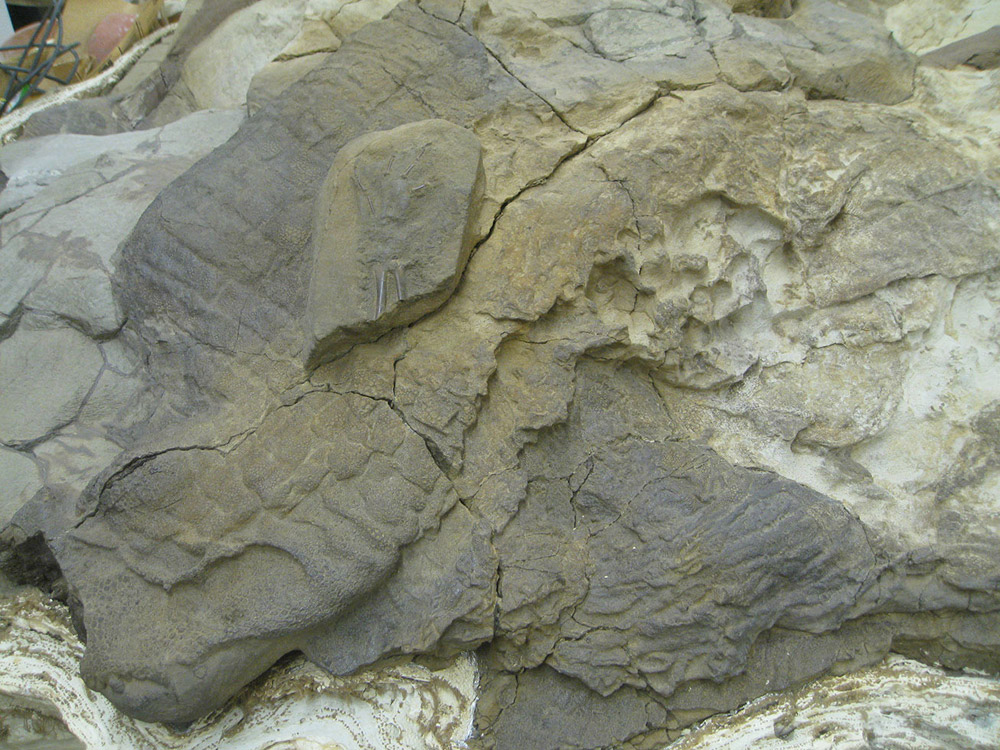
One of the most interesting dinosaurs of the Hell Creek Formation was the Tyrannosaurus rex (tye RAN oh SORE us recks). T. rex was a huge, fierce, flesh-eating dinosaur. (See Image 19.) This dinosaur was the largest meat-eating land animal that ever lived in North Dakota. A large adult might have been 40 feet long and 20 feet tall when standing upright. The head alone was about five feet long. Paleontologists study the teeth to decide whether an animal was an herbivore (plant-eater) or a carnivore (meat-eater). T-rex was definitely a meat eater. Its teeth (about 50 of them) could be as large as a small banana. Each tooth had serrated edges and was set in a jaw that could bite with the force of 12,800 pounds. This was like being crushed by six Volkswagen Beetles. The claws on their front feet could grasp and tear at their prey. In addition, the T. rex was a pretty good runner. Scientists debate whether the T. rex was a predator of living animals or a scavenger of dead or dying animals. T. rex often ate its Hell Creek neighbors of the Edmontosaurus and Triceratops species. The fossil record in North Dakota has not yet turned up an entire T. rex skeleton. Teeth and individual bones have been recovered, so we know that the T. rex lived, hunted, and died in North Dakota.
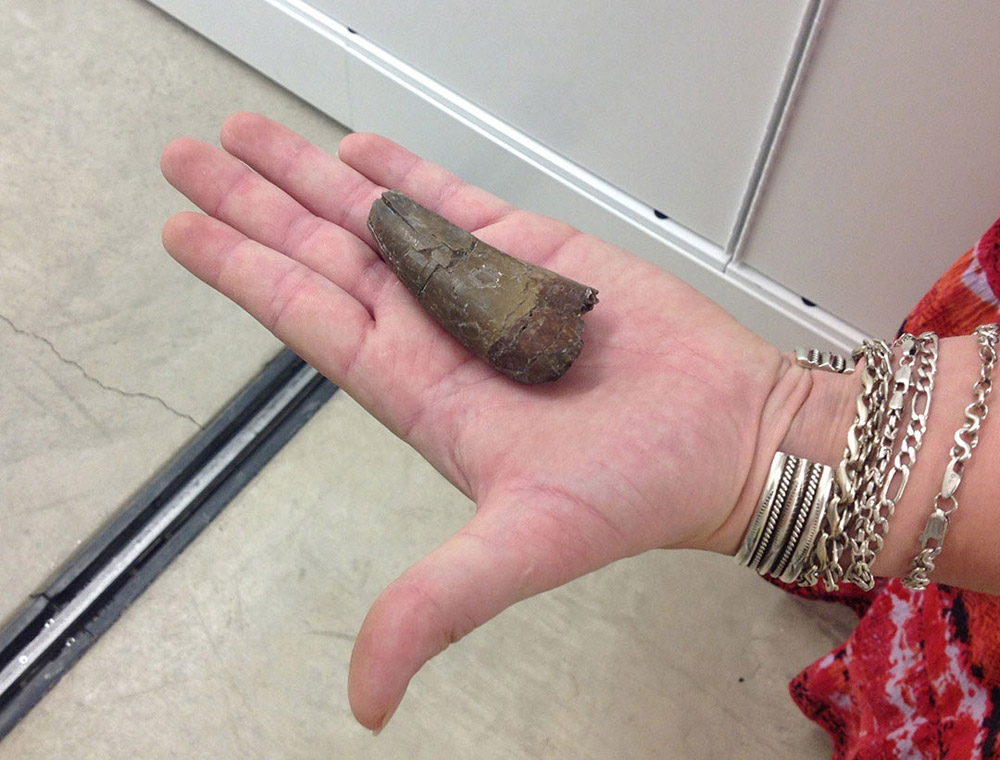
The residents of the Hell Creek delta included flying reptiles. The largest of these was the Pteranodon (ter RAN oh don) which is thought to have been the first vertebrate animal to develop the ability of sustained flight. That was back in the Triassic Period. By the late Cretaceous, the Pteranodons had a smallish body (35 pounds) with a wingspan of 20 feet. They could soar and probably spent most of their time flying over water. Pteranodons had webbed feet and fur. They had long, bony crests at the back of their heads. Lacking teeth, they scooped up fish from the seas.
The K-T Boundary resulted in the extinction of all of the dinosaurs and many other reptiles. Whether the extinction was caused by the impact of a huge asteroid or some other cause, it is clear to paleontologists that dinosaurs and many other species died out completely about 65 million years ago. The survivors tended to be smaller animals. With the reptiles gone, the stage was set for the rise of mammals.
Why is this important? Extinction is a difficult idea to think about. The extinction of the dinosaurs at the end of the Cretaceous Period (the K-T boundary, also called the Cretaceous-Paleogene extinction) is one of the five greatest mass extinctions. About 75 percent of all species became extinct 65 million years ago.
However, the loss of one kind of animal opened the door for other creatures. The surviving species prospered because they had better access to food and water resources and perhaps fewer predators. If they adapted to changing environmental conditions, the species continued to evolve.
Studying dinosaurs not only tells us something about the world we live in and the animals we share it with, it also offers an opportunity to understand more about how life continues as animals (and plants) adapt, or fail to adapt, to changing environmental conditions.
Today, paleontologists believe that birds are the last remaining descendants of dinosaurs.
Animals of the Eocene and Oligocene Epochs
During the Eocene Epoch (55 to 34 million years ago), the average temperature was more than 20 degrees warmer than today. Dense tropical forests covered North Dakota. Rodents, fish, reptiles, birds, and many kinds of mammals lived during the Eocene Epoch.
Large mammals wandered into North Dakota from Asia across the Bering Land Bridge.The Bering Land Bridge (also called Beringia) was a stretch of land that opened between Alaska and Siberia as temperatures cooled all over the world and ice caps formed on the poles. The ocean level dropped and a ridge that had been under the sea connected northwest Alaska with Siberia. Many millions of years later, the bridge formed again, allowing other migrations of land animals and humans from Asia into North America. The Coryphodon (kor RIF oh don) was similar to, but larger than, the modern hippopotamus. This animal probably wandered in swamps eating swamp plants. It was large and slow, with a very small brain. The Coryphodon was probably the dullest mammal of all time.
The first horse, the ancestor of all modern horses, roamed the northern plains browsing on leaves. It looked much like a deer, but was about the size of a small dog with four padded toes on the front feet and three padded toes on the back feet. This animal has two names: Eohippus (ee oh HIP us) or dawn horse; and Hyracotherium, (hye rack oh THEER ee um) or hyrax-like beast, a mistaken name that the little horse has been stuck with for more than 100 years.
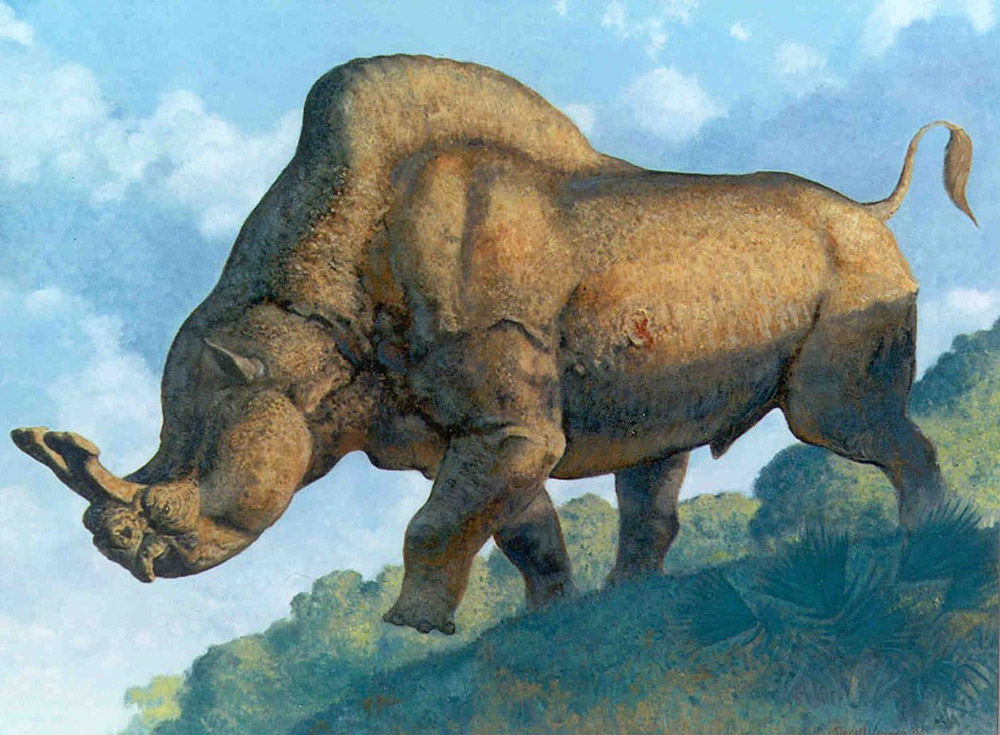
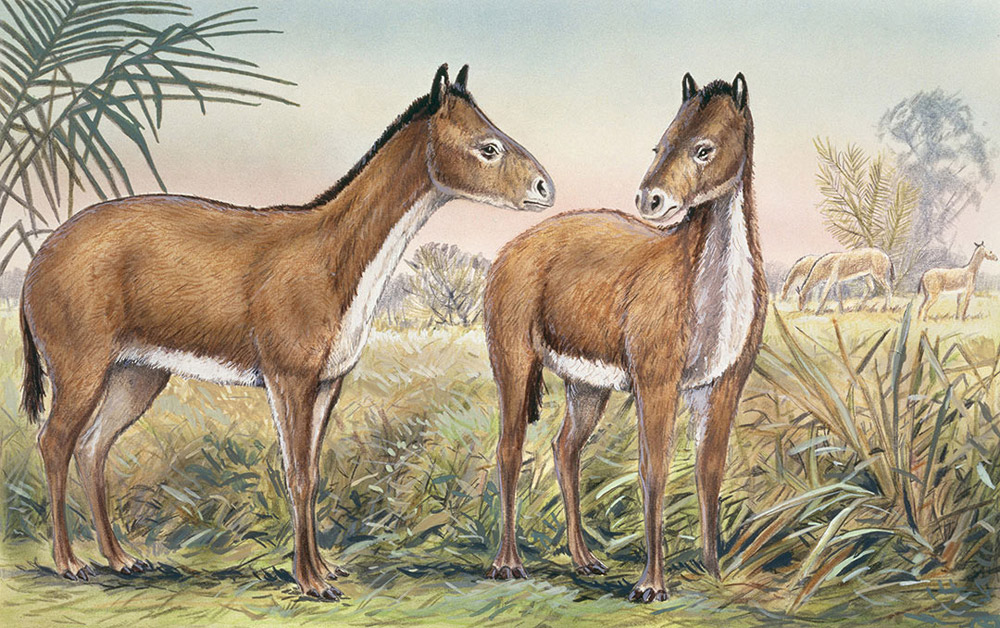
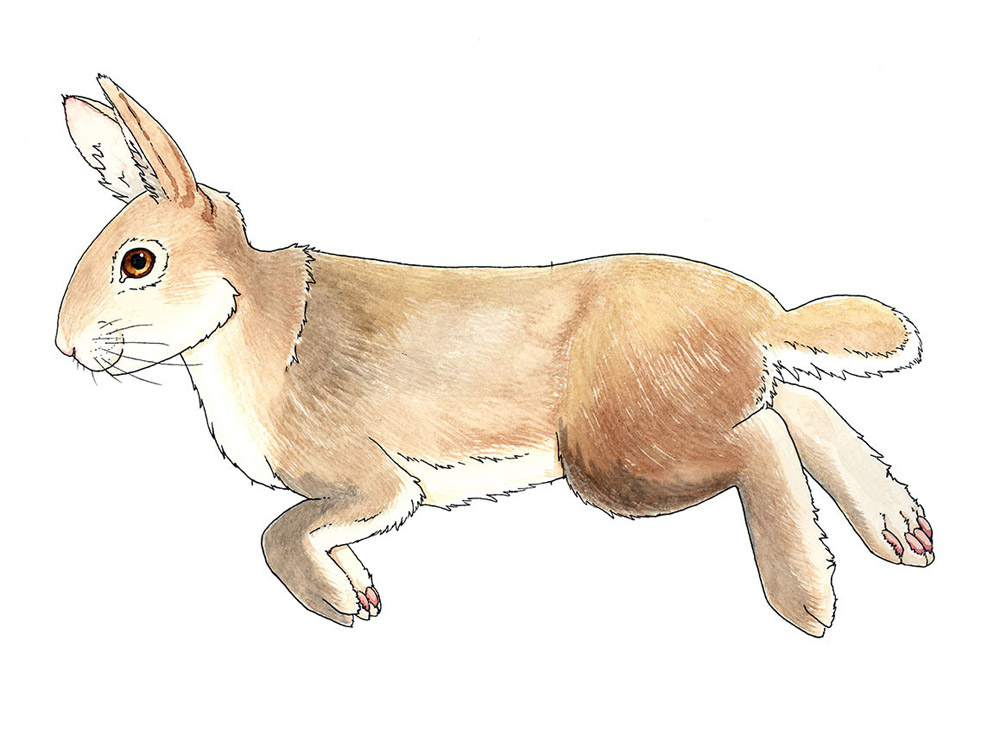
The Eocene Epoch ended as the global temperature dropped and the climate became drier. A few alligators managed to survive in lowland swamps during the early Oligocene Epoch, but the changing climate did not support the animals that had thrived during the Eocene.
The Oligocene Epoch began about 33 million years ago and lasted 10 million years. North Dakota became a treeless plain covered with shrubs, plants, and a few grass species. The temperature was mild and rain fell occasionally. Huge mammals roamed North Dakota. The Thunder Beast (Brontops or titanothere) (See Image 20.) was eight feet tall at the shoulder. It had bony projections on its snout that made this plant-eater a pretty intimidating fellow. The titanothere (tye TAN oh theer) lived early in the Oligocene Epoch, but as the climate became drier, it probably did not make a successful adaptation to the new environment.
Eohippus evolved into Mesohippus (mee zoh HIP us) or “middle horse.” (See Image 21.) This horse was a little larger than Eohippus, but still small (two feet tall at the shoulder) and deer-like. Mesohippus had three front toes. Over millions of years, the middle toe evolved into the single toe, or hoof, of the modern horse. Mesohippus browsed on leaves. Unlike modern horses, Mesohippus was not a grazer and probably ate very little grass.
There were also early ancestors of camels (Poebrotherium). Camels first evolved in North America, but eventually died out. The ancestors of modern camels survived in the Middle East, Africa, and Asia. North Dakota’s Poebrotherium (po bro THEER ee um) was about the size of a goat and lacked the humps that modern camels have on their backs. The camel shared the plains with the early deer, Leptomeryx (lep toe MARE icks), a small, antler-less, two-toed animal that could run quite well.
Among the fierce predators of the Oligocene were the saber-toothed cats. One of these, the Dinictus (din ICK tuss) was not a true cat, but looked like a cat with long, serrated canine teeth used to stab and slash prey.
Other Oligocene animals included rabbits (Palaeolagus: pay lee oh LAG us) (See Image 22.) that were about 10 inches long. There were also four-foot-long tortoises of the genus Stylemys (sty LEM mees) (See Image 23.) and sweat bees (Celliforma species: sell ih FORM ah.) Rodents were very common. The Eumys (YOU miss) species were the forerunners of modern rats, mice, hamsters, and voles.
Why is this important? Life forms, both plant and animal, evolved in North Dakota over millions and millions of years. Animals changed and adapted as the changing climate affected plants, water sources, and temperature. Animals that did not adapt or evolve, migrated away or died out as the environment (food, water, and habitat) they depended upon changed. Evolution was a slow process involving a tangle of elements including the climate, the kind of food sources such as plants, and the availability of water.
The relationships between plants, animals, and the climate can be illustrated with this example. Ancient horses required shrubs to feed on. When the climate changed, those shrubs disappeared because the temperature dropped or the rainfall diminished. Horses would have to adapt in some way. They might have roamed farther to find food, or had fewer offspring. As Eohippus sought a more favorable environment, the meat-eating predators that depended on horses for food either had to find other sources or follow Eohippus.
Another possibility: if the Eohippus population decreased because the food source was not available, the weakened horses might have succumbed to the hunger of larger, stronger predators, including humans. Only the larger, faster horses could survive this challenge. It took a very long time, but the fossil record reveals that life continues, but the forms change.
Animals of the Pleistocene Epoch
By the time the Last Great Ice Age began, about 1.8 million years ago, the animals of North Dakota were very different than they were 30 million years earlier. The climate was much colder and glaciers carved through the eastern portion of North Dakota. The animals that lived here had to be well-adapted to cold conditions.
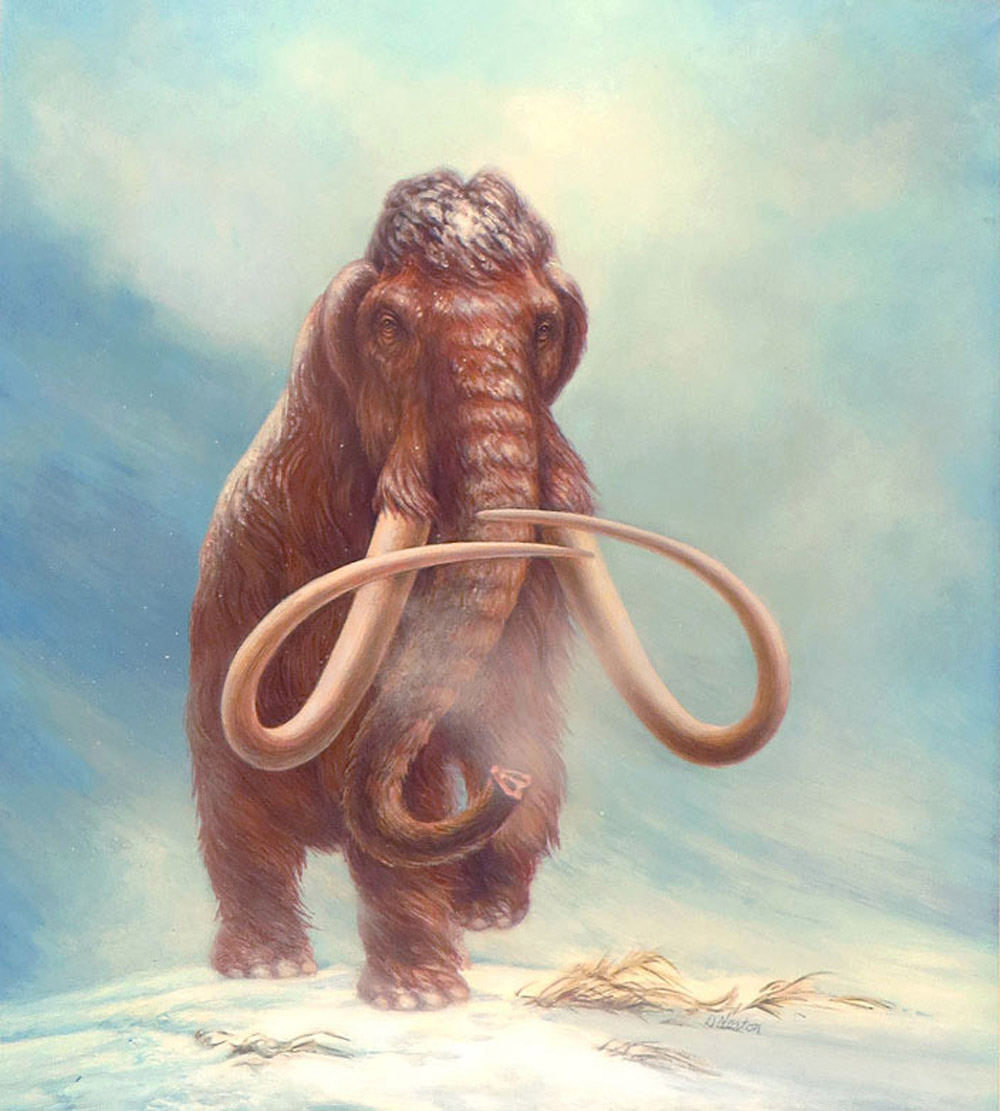
Wooly mammoths (Mammuthus primigenius: mah MOO thuss prime eh GENE ee us) came from Asia across the Bering Land Bridge that had opened once again as the climate cooled. (See Image 24.) Mammoths were common in North Dakota, but ours were among the smaller of the mammoth species. They only reached to nine feet at the shoulder. They ate grass, roots, and tree bark which they loosened with their huge tusks. The tips of their trunks were capable of grasping food. Their heavy coats were dark brown. They had a soft, fine undercoat that kept them warm. Mammoths lived through the Ice Age and became extinct about 10,000 years ago - about the same time that humans began to live in North Dakota.
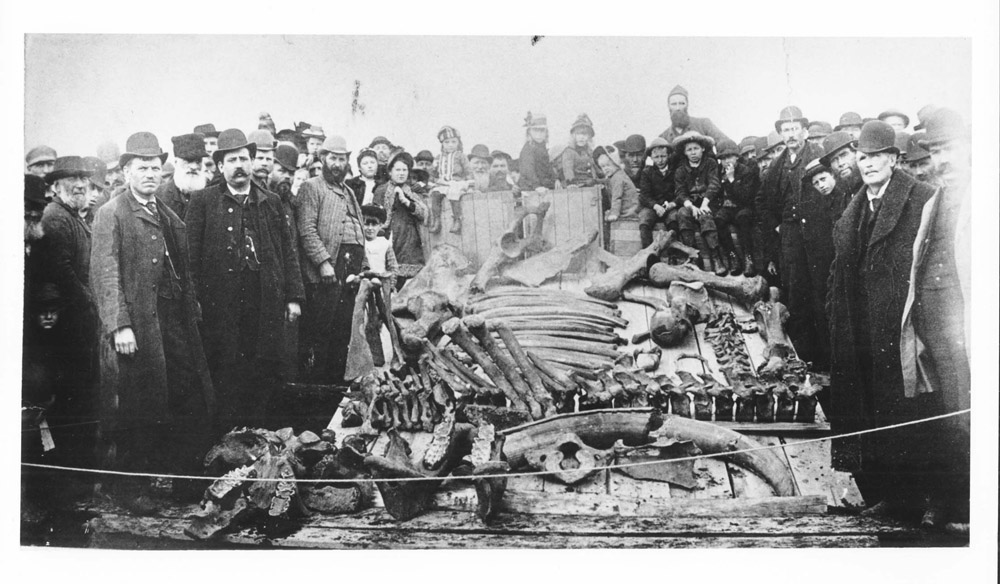

Mastodons (Mammut americanum: ma MOOT ah mare eh KAN um) were similar to mammoths, but have a very different life story. While mammoths migrated from Asia, mastodons evolved in North America over millions of years. They were about 10 feet tall at the shoulder. Like mammoths, mastodons had long curved tusks that they used to tear bark from trees. The tusks that have been found indicate that mastodons probably had a preference for either their right or left tusk because one is usually worn more than the other. (See Image 25.) They had long, dark, thick hair coats with a fine undercoat for warmth. MastodonsMastodons that died in icy regions were sometimes caught in glaciers or ice packs. These specimens still have intact hair so we know that they were covered with dark, coarse hair with a dense wooly undercoat for warmth. In 2007, reindeer herders in Siberia came across the carcass of a one-month-old mastodon that died 40,000 years ago after she fell into a muddy creek bank. Her body was mummified by mud, ice, and bacteria. Russian scientists named her Lyuba and hurried to preserve the remaining flesh. Scientists have been able to learn a great deal about pre-historic animals by studying Lyuba’s remains. were browsers that ate leaves and bark, but little grass. They tended to live in boggy areas as moose do today. Mastodons became extinct about 10,000 years ago. (See Image 26.)
Another enormous Ice Age mammal was the Bison latifrons (BYE zon LAT ih fronz). This is the ancestor of the modern bison, but it was about 25 per cent larger than today’s bison (Bison bison.) The horns were seven feet from tip to tip. These animals lived in small herds and preferred woodlands habitats.
Horses still ran across North Dakota in the Ice Age. They had become more like the modern horse and have the same genus name, Equus (EE kwus.) Ice Age horses were larger than their ancestors (Hyracotherium, Mesohippus and others) and had only one toe with a hard hoof. They had become grazers who depended on grass for their main source of food. However, horses became extinct in North Dakota and North America toward the end of the Ice Age.
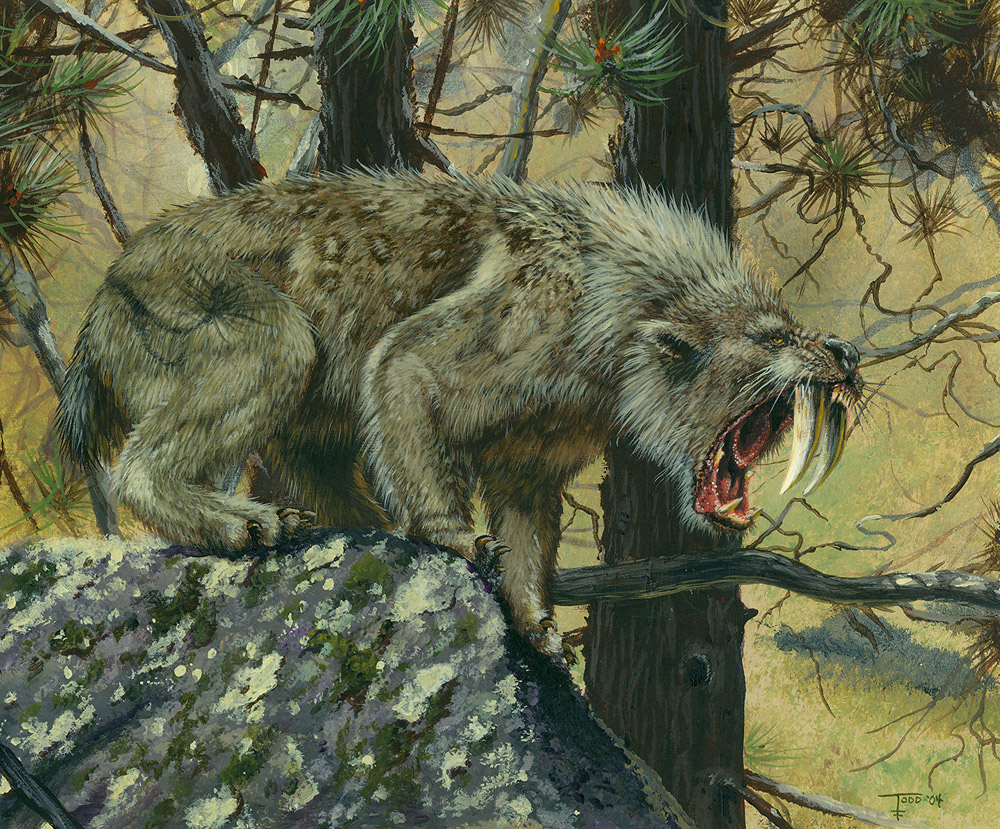
All of these mammals faced fearsome predators, especially the Smilodon fatalis (SMILE oh don fah TAL iss), (See Image 27.) better known as the saber-toothed cat. This cat was a little smaller in length (four to five feet) and height (three feet) than a modern lion, but it was heavier at 440 pounds. It had very powerful front legs and could spring onto its prey and slash the flesh with its seven-inch-long canine teeth. Smilodons sometimes bit into the skull of their prey and broke their canines on the hard bones of the skull. Their jaws opened to an angle of 120 degrees which allowed them to take a large bite in the neck or head of their prey.
The Smilodon, like many other Ice Age animals, was extinct by the end of the Ice Age. Scientific data so far tells us that the larger Ice Age animals such as the mastodon and the horse became extinct while the small to medium-sized animals such as the deer survived. No one knows the cause of the extinction, but during the late Ice Age in North America, humans were hunting these animals. As the climate warmed at the end of the Ice Age, large animals well-adapted to cold conditions faced environmental challenges. At the same time, human hunters played a part in the complex relationship between life and death.
Why is this important? The end of the Ice Age coincides with the end of the Pleistocene Epoch. As the Pleistocene ended and the Holocene Epoch began, an entirely new form of animal life appeared on the plains of North Dakota. Humans had immigrated to North America from Asia. Their migrations brought them to North Dakota, where they hunted and co-existed with the animals of the Late Pleistocene and Early Holocene. Human hunters needed food for their own survival. They not only hunted the great beasts, they ate the same wild fruits and plants that some of the animals ate. They brought tame animals (dogs) with them, and some scientists think that they also brought diseases that might have made Ice Age animals sicken and die.
The record of the Pleistocene gives us a little more information about animal life in North Dakota, but we haven’t yet answered the questions about how life forms evolved and why extinctions occurred. In our recent past, humans have brought many new species of plants to North Dakota and have interfered with many natural aspects of climate, soil, and waterways. As we experience climate change, the study of past climates and animal life may help us to understand what these changes will mean for us. There is much work yet to be done.



